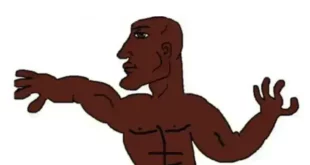Stuff Black People Don’t Like
November 15, 2013
The typhoon in the Philippines was bad.
Real bad.
But the people of the Philippines will rebuild.
They will recover.

They will survive Mother Nature’s fury and grow stronger as a nation.
The same cannot be said of Detroit, post-white people (yes, Detroit was nearly 100 percent white only 100 years ago and more than 85 percent white in 1950).
Law and order will be restored to the Philippines, where Typhoon Haiyan was momentary glimpse of Armageddon, a maximum category-five storm with gusts of up to 235 miles per hour winds.
The black population of Detroit, since the election of Coleman Young as the first black mayor in 1973, has presented America a non-stop view of what a world devoid of western civilization looks like.
Law and order were swept away from Detroit, with Young’s inauguration in 1974, with a speed far greater than the category-five winds that hit the Philippines.

And they’ve never stopped blowing away the vestiges of western civilization.[Detroit Church Leaders Push ‘Thou Shalt Not Kill’ Message After Deadly Shootings, CBS Detroit, 11-7-13]:
Church leaders hope “Thou Shalt Not Kill” posters and billboards will help quell the escalating deadly violence in Detroit.
About 24 hours after three people were killed and six others were wounded in a shooting at an east side barber shop, local clergy members will hold an emergency meeting to talk about what they can do to help reduce violent crime in Detroit.
“We all have to do what we can do, and right now we don’t have a respect in our communities for life; we don’t have a respect for many things,” said Minister Ovella Andreas. “But we still have to create a standard to hopefully have a consciousness about God …. because even our people have become apathetic.”
Andreas said, through their “Thou Shalt Not Kill” campaign, they’ve already been working for the past two years to combat crime in urban neighborhoods.
“Our goal now is to infiltrate and saturate our communities with this commandment, via buses, via billboards,” she said. “The churches have posters — we’ll put them into the businesses in the area.”
“Thou Shalt Not Kill” is one of the Ten Commandments listed in the Bible’s Old Testament. Andreas said the hope is to unite enough Detroit churches and leaders to spread that urgent message.
“This is an emergency; this is a crisis, and we have to come together now to do what we can,” she said. “I truly know if we do what we can, God will do what we cannot; but we’re not doing all that we can.”
The group had also worked to get the city to designate every twenty-second day of the month as “Stop the Violence Day.”
Anarchy, 24-7, 365 days a year in Detroit.
The Philippines have looters, crime, and mayhem only because of the momentary breakdown in law and order due to a typhoon; Detroit has no natural disaster to blame.
Only race can explain the mess of 2013 Detroit. [Detroit’s bankruptcy brings up more than finances : The issue of race has hovered persistently around the trial, with some black residents likening the loss of local control and the sale of assets to slavery and neocolonial plundering, Los Angeles Times, 11-9-13]:
Sheilah Johnson was a building inspector for the city for 28 years, a college graduate who passed up jobs that paid more because a city job offered stability and the promise of a good pension.
But the city’s recent plunge into bankruptcy — overseen by an outside emergency manager answerable to the state government, not the citizens of Detroit — makes her wonder whether she and other African American residents of the impoverished city will be able to stop Wall Street creditors from seizing what’s left of a municipal treasury they paid into for most of their lives.
“When my 9-year-old grandson asks me, ‘Grandma, are they trying to make us slaves again?’ how do I answer that child?” Johnson said, breaking into tears during court hearings over the city’s bid to launch the nation’s largest-ever municipal bankruptcy. “We do not need a slave owner, and I am not a slave.”
Much of the trial to determine whether this onetime powerhouse of the American economy is eligible for bankruptcy has focused on such nuts-and-bolts issues as debt structuring and pension liabilities. But the issue of race has hovered persistently around the trial, which wrapped up Friday. The move to secure and sell off remaining assets — including art museum treasures and valuable real estate — was portrayed by many African American residents who showed up in court to try to halt the bankruptcy as neocolonial plundering.
They said possible cuts to public pensions would disproportionately target black workers who were left with nothing but government jobs after industry fled, along with most white residents, to the suburbs. Racial tensions were only inflamed a week ago when a white man shot and killed a black woman who was seeking help after her car broke down in a suburb.
“There are two big elephants in this courtroom — race and democracy — and that’s what makes this whole case a little bit different from the typical bankruptcy case I endured during my tenure as a law student,” said Sam Riddle, a political consultant who has followed the case.
U.S. Bankruptcy Judge Steven Rhodes said he would rule after additional briefs are filed next week on whether the city can remain under federal bankruptcy protection. City unions and retired employee groups — organizations with large African American representation — have argued that the bankruptcy is an attempt to get around a ban on pension cuts in the Michigan Constitution.
In Detroit, which last week elected its first white mayor in four decades, it is nearly impossible to escape discussion of race. The city’s population is 82% African American, in a state that is 79% white.
That division began in 1943, when a race riot that lasted for days drove the first waves of residents out of the city, a move exacerbated by riots in 1967 in which 43 people died. Now, Detroit is considered the most segregated metropolitan region in the country.
“You can drive around now and not see a white person all day long,” said the Rev. Charles Williams II, who watched much of the trial and was one of nearly 1,000 protesters outside the court last month.Many in Detroit would strongly disagree with the race narrative. After all, statistics alone highlight just how much Detroit needs help, from wherever it comes: The city, whose population has declined 63% since its postwar peak, has the highest violent crime rate of any big city; 40% of its street lights don’t function
Some days, McLellan takes a loop through Belle Isle, a city park open to all Michiganders. Anyone can still come to Detroit to use its parks and see its sports teams, she said, but were she to drive to the suburb of Grosse Pointe, she wouldn’t be allowed in its parks. Only residents with ID cards are allowed in.“You’ve got folks internalizing that all the problems with Detroit are because of the black population that lives in Detroit,” McLellan said. “But in reality, all the factories moved out to the suburbs, all downtown up and moved, and they took the economy out.”
The result: More than a third of the city’s 700,000 residents now have incomes below the poverty level. Per capita income is just $14,000. And the librarians, trash haulers, teachers and police officers who have depended on public paychecks now see even those lean futures at risk.
Detroit, McLellan said, is reminiscent of New Orleans, another major U.S. city where African Americans were left powerless to fend off disaster. “It’s another Katrina-type situation,” she said.
 Daily Stormer The Most Censored Publication in History
Daily Stormer The Most Censored Publication in History


